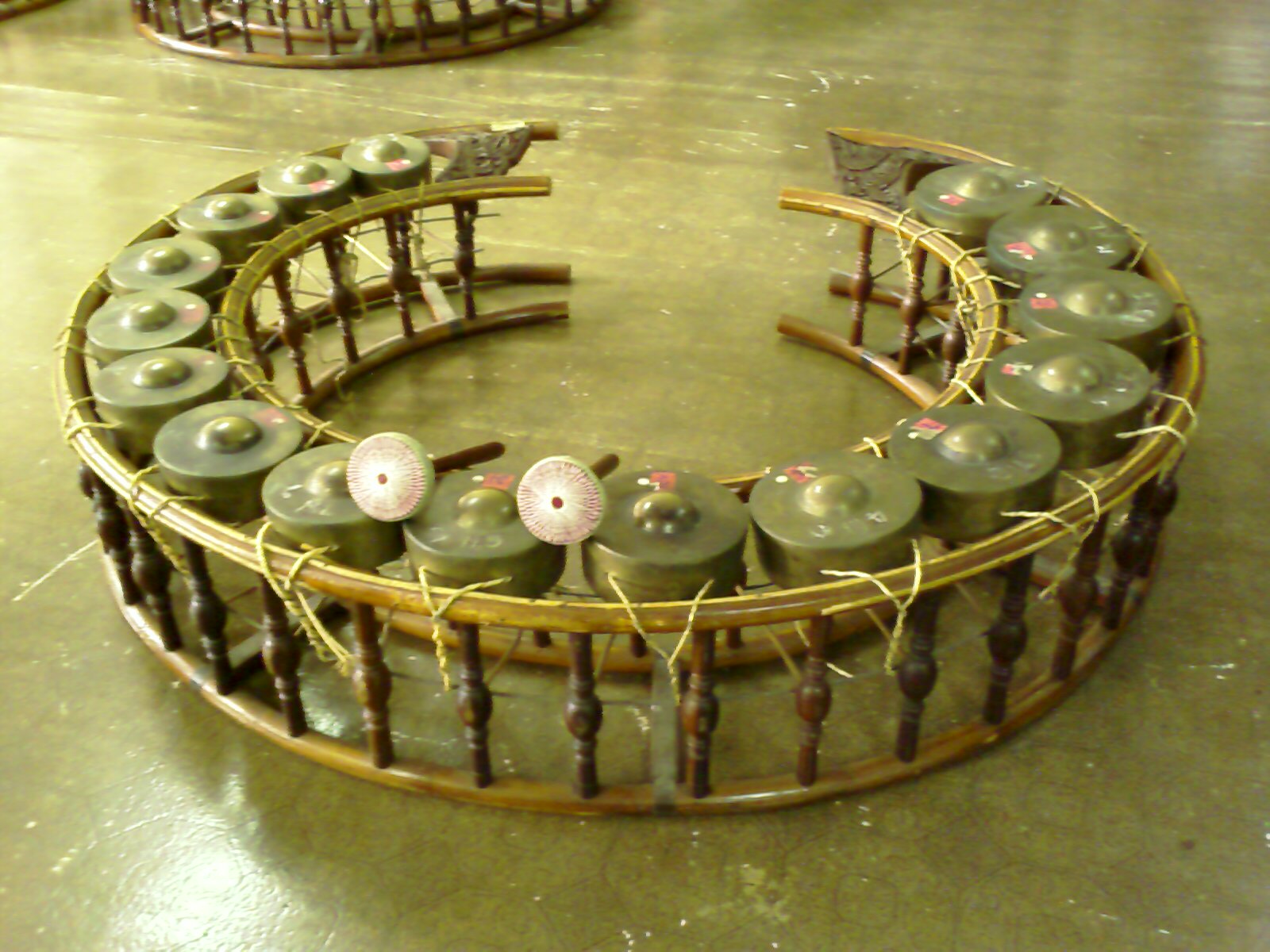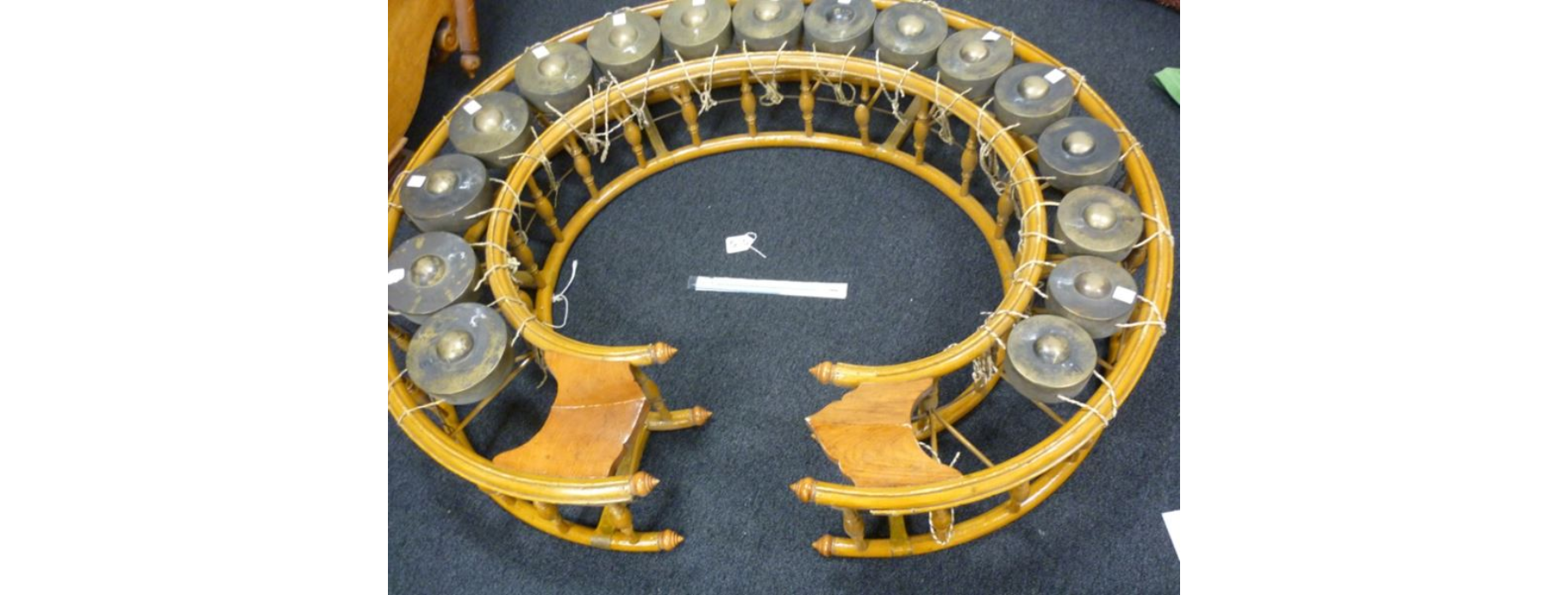Khong Wong Yai
Melodic Percussions
Asia
Between 1001 and 1900 AD
Video
The Khong Wong Yai is a traditional Thai musical instrument that belongs to the percussion family. It is one of the most significant instruments in Thai classical music and is widely used in various cultural and religious performances. As a vital component of the Piphat ensemble, the Khong Wong Yai plays a crucial role in creating the melodious and rhythmic foundation of Thai music.
This circular gong chime consists of multiple small gongs arranged in a semi-circle and played with mallets. The instrument is not just an essential part of Thai musical heritage but also serves as a symbol of the country’s rich cultural traditions. The Khong Wong Yai is a perfect representation of Thai craftsmanship, blending both artistic beauty and musical complexity.
Description and Type of Instrument
The Khong Wong Yai is a percussion instrument classified under the idiophone family, which means it produces sound through the vibration of its own material without requiring strings or membranes. The instrument is distinctive due to its unique circular arrangement of gongs, which allows the musician to play it with agility and precision.
Physical Structure and Components
The Khong Wong Yai consists of the following key components:
Gongs: The instrument comprises 16 small metal gongs, each carefully tuned to a specific pitch. These gongs are arranged in a circular wooden frame and suspended by cords, allowing them to resonate freely when struck.
Wooden Frame: The frame, which holds the gongs, is typically made of carved wood and is intricately decorated with traditional Thai patterns. The circular shape enables the player to move smoothly around the instrument while striking the gongs.
Mallets: The musician plays the Khong Wong Yai using two mallets, which are padded at the tips to produce a clear, resonant sound. The player skillfully strikes the gongs to create melodic sequences that contribute to the overall harmony of an ensemble.
Type of Instrument
The Khong Wong Yai is categorized as a gong chime, a type of idiophone that produces different pitches based on the size and tuning of its gongs. It is part of the Piphat ensemble, a traditional Thai musical ensemble used in royal, religious, and theatrical performances.
There is a smaller version of the Khong Wong Yai known as the Khong Wong Lek, which consists of a similar structure but with smaller gongs that produce higher-pitched sounds. Together, these two instruments complement each other in creating a rich and dynamic musical texture.
History and Origin
The Khong Wong Yai has a long and fascinating history that dates back several centuries. It is believed to have evolved from earlier Southeast Asian gong chime instruments, which were influenced by Indian and Chinese musical traditions.
Origins in the Southeast Asian Musical Tradition
The origin of the Khong Wong Yai can be traced to the broader tradition of gong chime instruments found in various Southeast Asian cultures, including Myanmar, Cambodia, and Indonesia. The use of gongs in musical ensembles has been prevalent in these regions for centuries, with historical records suggesting their presence as early as the 13th century.
Ancient Thai musicians adopted and refined these musical elements, creating a uniquely Thai instrument that became an integral part of the kingdom’s classical music tradition. The Khong Wong Yai was developed during the Ayutthaya period (14th–18th century), when Thai classical music flourished, and musical ensembles became highly sophisticated.
Influence of Royal and Religious Traditions
The Khong Wong Yai was historically played in royal courts and temples, symbolizing prestige and spiritual significance. It was used in royal ceremonies, Buddhist rituals, and traditional theater performances such as Khon (masked dance-drama). The instrument’s role in religious and cultural events helped preserve its relevance over centuries, and it continues to be played in modern Thai classical music performances.
Types and Features
The Khong Wong Yai has distinctive features that set it apart from other percussion instruments. Although its primary structure has remained unchanged for centuries, different variations and playing styles have emerged over time.
Variations of the Khong Wong Yai
The Khong Wong Yai has two main variations based on size and function:
Khong Wong Yai: This is the standard version, consisting of 16 large gongs that produce deep, resonant tones. It is often used to play the main melody in traditional ensembles.
Khong Wong Lek: A smaller counterpart to the Khong Wong Yai, this version has smaller gongs that produce higher-pitched tones. It is often used to complement the Khong Wong Yai, adding brightness and variation to the musical arrangement.
Notable Features
Unlike other percussion instruments that are linear or rectangular, the Khong Wong Yai is arranged in a circular frame, making it unique in terms of playing technique. Each gong is meticulously tuned to a specific pitch, allowing the instrument to produce a full range of melodic tones. The gongs are made of high-quality metal alloys, producing a deep, long-lasting resonance when struck. The wooden frame is often adorned with traditional Thai carvings and gold accents, showcasing the artistry of Thai craftsmanship.
Work Mechanics and Playing Technique
The Khong Wong Yai requires a high level of skill and precision to play effectively. Musicians use both hands to strike the gongs with mallets, creating complex rhythmic and melodic patterns.
Playing Technique
The musician sits inside the circular frame, allowing them to reach all the gongs with ease. The playing technique involves:
Hand Coordination: The player uses two mallets to strike the gongs in succession, creating a flowing melody.
Dynamic Control: By adjusting the force and speed of the strikes, the musician can produce variations in volume and intensity.
Rhythmic Patterns: The Khong Wong Yai often follows a specific rhythmic cycle, playing in harmony with other instruments in the Piphat ensemble.
Performance Context
The Khong Wong Yai is typically played in ensemble settings rather than as a solo instrument. It provides a melodic framework for the entire musical composition, often leading the melodic direction while being supported by drums, xylophones, and wind instruments.
Role in Music
The Khong Wong Yai is one of the most important instruments in Thai classical music and is widely used in different types of performances.
Primary Functions in Thai Music
The Khong Wong Yai plays a central role in shaping the melodic structure of traditional compositions. It helps maintain the tempo and rhythm, ensuring that all instruments in the ensemble remain synchronized. Skilled musicians use embellishments and variations to add expressiveness to the performance.
Ensemble Performances
The Khong Wong Yai is a key component of the Piphat ensemble, which includes instruments such as:
- Ranat Ek (xylophone)
- Ranat Thum (bass xylophone)
- Pi Nai (reed instrument)
- Klong That (drums)
Together, these instruments create a rich and dynamic musical experience.
Significance of the Khong Wong Yai
The Khong Wong Yai is more than just a musical instrument—it is a symbol of Thai cultural identity and artistic excellence.
Cultural and Religious Importance
The instrument is played during temple ceremonies and religious festivals, adding a sacred element to worship. Historically, the Khong Wong Yai was played in royal courts, signifying prestige and tradition. It is used in Thai theatrical performances such as Khon and Lakhon, adding musical depth to dramatic storytelling.
Modern Relevance
Despite its ancient origins, the Khong Wong Yai remains relevant today. It is taught in Thai music schools, performed in cultural events, and adapted into contemporary music compositions.
The Khong Wong Yai is an extraordinary Thai musical instrument with a rich history, unique design, and essential role in traditional and contemporary music. Its melodious gongs, circular arrangement, and artistic craftsmanship make it a standout instrument in Southeast Asian music traditions. Whether in religious ceremonies, royal courts, or modern performances, the Khong Wong Yai continues to be a cherished symbol of Thailand’s cultural heritage.
FAQ
What is the historical origin of the Khong Wong Yai?
The Khong Wong Yai has its origins in the Sukhothai period (1238-1350), where it was used by court musicians. Over time, it has evolved to become a central instrument in Thai classical music.
What type of instrument is the Khong Wong Yai?
The Khong Wong Yai is a percussion instrument, specifically a type of gong circle used in Thai classical music.
What material is used to tune the gongs of the Khong Wong Yai?
The gongs of the Khong Wong Yai are tuned using beeswax placed under each gong. This helps achieve the desired pitch and improves the tone quality.
 Links
Links
References
Other Instrument
Categories



















